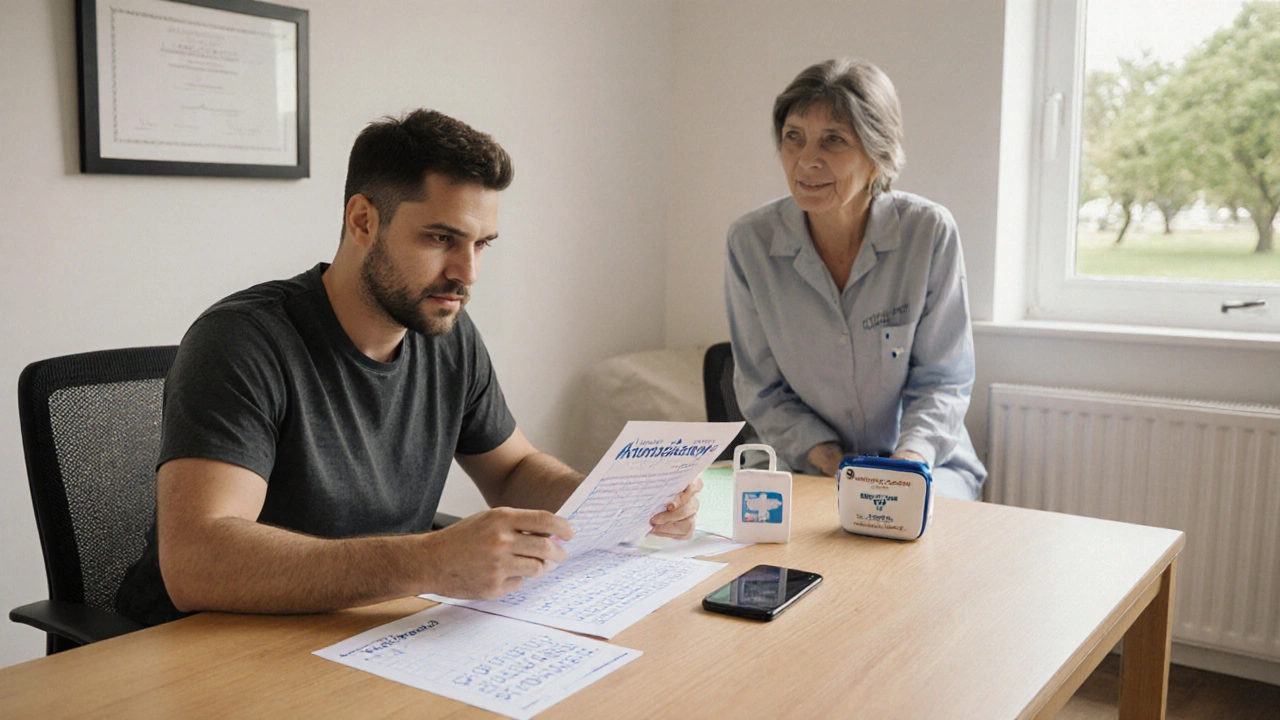
SPD Self-Advocacy Toolkit
Your Toolkit Overview
This interactive guide helps you prepare for medical appointments with essential tools and communication strategies.
Communication Framework
Learn the ASK-CLO method for effective conversations with your healthcare team.
Your Self-Advocacy Toolkit
Prepare these items before each medical appointment to ensure you get the most from your visit.
1. Medical Summary Sheet
List diagnoses, latest MRI findings, medication doses, and any side-effects you've noticed.
2. Goal-Setting Sheet
Write 1-3 short-term goals (e.g., "run 3 km without fatigue") and 1-2 long-term goals (e.g., "maintain independence for 5 years").
3. Question Bank
Prepare 3-5 specific questions for each appointment.
4. Support Contact List
Include your Neurologist, physiotherapist, local Support Group coordinator, and a trusted family member.
5. Assistive Tech Inventory
Note any apps, wearable sensors, or mobility aids you use, plus their battery life and warranty details.
ASK-CLO Communication Framework
Use this structured approach to communicate effectively with your healthcare providers.
A Acknowledge
Start with a brief recap of what's been working.
S State the Problem
Use concrete data (e.g., "I've had 2 hours of fatigue after my morning run").
K Know Your Goal
Mention the specific outcome you want (e.g., "Adjust my medication to reduce fatigue").
C Clarify Options
Ask for alternatives and the pros/cons of each.
L Listen Actively
Restate the clinician's answer to confirm understanding.
O Organize Next Steps
Write down agreed actions before you leave.
Legal Rights & Funding Options
Understand your rights under the Disability Discrimination Act 1992 and available financial supports.
- NDIS: Funds assistive technology, therapy sessions, and personal care aides.
- Medicare Chronic Disease Management Plan: Allows up to five allied-health visits per year.
- Commonwealth Senior Health Card: Reduces prescription copays for patients over 65.
Quick Reference Checklist
Living with a secondary progressive disease (SPD) while staying active can feel like walking a tightrope - you want to push your limits, but you also need the right support to avoid falling off. This guide shows you how to become your own best champion, from mastering medical conversations to leveraging legal protections and community resources.
Key Takeaways
- Know the core elements of self advocacy and why they matter for SPD.
- Use a four‑step communication framework to get clear answers from any clinician.
- Tap into Australian legal rights, insurance options, and local support groups.
- Integrate assistive tech and a personalized care plan without ditching your active lifestyle.
- Create a printable advocacy checklist you can reference before every appointment.
What Is Self‑Advocacy for an SPD Patient?
Self‑advocacy means speaking up for your health needs, making informed choices, and ensuring the system works for you rather than the other way around. For someone with a secondary progressive disease - most commonly Secondary Progressive Multiple Sclerosis is a stage of MS where disability steadily worsens after an initial relapsing‑remitting phase - this translates into regular check‑ins with specialists, proactive symptom management, and clear documentation of goals.
Build Your Advocacy Toolkit
Before you walk into any consultation, assemble a "toolkit" that turns vague concerns into actionable requests. Below is a practical checklist you can copy into a notebook or phone app.
- Medical Summary Sheet: List diagnoses, latest MRI findings, medication doses, and any side‑effects you’ve noticed.
- Goal‑Setting Sheet: Write 1‑3 short‑term goals (e.g., "run 3km without fatigue") and 1‑2 long‑term goals (e.g., "maintain independence for 5years").
- Question Bank: Prepare 3-5 specific questions for each appointment (see the table later).
- Support Contact List: Include your Neurologist - the doctor who oversees disease‑modifying therapy, physiotherapist, local Support Group coordinator, and a trusted family member.
- Assistive Tech Inventory: Note any apps, wearable sensors, or mobility aids you use, plus their battery life and warranty details.

Communicating Effectively with Your Care Team
Doctors and therapists are busy, but they’re more likely to act when you give them clear, concise information. The "ASK‑CLO" framework works well for SPD patients:
- A - Acknowledge: Start with a brief recap of what’s been working.
- S - State the problem: Use concrete data (e.g., "I’ve had 2hours of fatigue after my morning run").
- K - Know your goal: Mention the specific outcome you want (e.g., "Adjust my medication to reduce fatigue").
- C - Clarify options: Ask for alternatives and the pros/cons of each.
- L - Listen actively: Restate the clinician’s answer to confirm understanding.
- O - Organize next steps: Write down agreed actions before you leave.
Here’s a quick reference table you can paste into your phone notes:
| Tool | Pros | Cons |
|---|---|---|
| Written Action Plan | Creates a permanent record; easy to share with multiple providers. | May feel formal; requires printing. |
| Digital Health App (e.g., MyMS Manager) | Instant updates; can export PDFs for appointments. | Depends on internet; learning curve. |
| Caregiver Advocate | Provides emotional backup; can repeat questions if you forget. | Needs a trusted person; may influence the tone of discussion. |
Know Your Legal Rights and Funding Options
Australia’s Disability Discrimination Act 1992 protects you from unfair treatment in health care, employment, and public services. In practice, this means you can request reasonable adjustments - for example, extra time for physiotherapy or wheelchair‑accessible gym equipment.
Key financial supports include:
- National Disability Insurance Scheme (NDIS): Funds assistive technology, therapy sessions, and personal care aides. Eligibility hinges on functional impact, not diagnosis alone.
- Medicare Chronic Disease Management Plan: Allows up to five allied‑health visits per year under a GP‑issued plan.
- Commonwealth Senior Health Card: Reduces prescription copays for patients over 65 or on certain income thresholds.
When you’re unsure which program fits your situation, contact a local Patient Advocacy officer or the MS Society’s helpline. They can walk you through paperwork and appeal processes.
Staying Active Without Overloading Your Body
Exercise is a proven disease‑modifying factor for MS, but the "one‑size‑fits‑all" approach doesn’t work for SPMS. Follow these evidence‑based tips:
- Start with low‑impact cardio (e.g., stationary bike, swimming) for 20‑30minutes, 3times a week.
- Incorporate strength training twice weekly, focusing on core and lower‑limb stability.
- Use a wearable fatigue monitor (many apps can alert you when heart‑rate variability spikes).
- Schedule "recovery days" - treat them as medication days, not optional rest.
- If heat worsens symptoms, exercise in a cooled environment or wear a cooling vest.
Your Rehabilitation Specialist can customize a program that respects your limits while challenging you to improve.

Create Your Personal Advocacy Plan
Take 15minutes each month to review the sections below, fill them out, and keep the document handy (paper or digital). This turns vague concerns into an actionable roadmap.
| Section | What to Fill In |
|---|---|
| Medical Snapshot | Current diagnosis, last MRI date, medication list, side‑effects. |
| Goal Tracker | Short‑term (3months) and long‑term (12months) functional goals. |
| Question Bank | 3-5 priority questions for the next appointment. |
| Support Network | Names, roles, and contact details of clinicians, friends, and groups. |
| Legal & Funding Checklist | NDIS application status, Medicare plan renewal dates, disability card expiry. |
| Tech & Equipment Log | Device name, purpose, battery life, warranty, and last service date. |
When you review this plan before each visit, you’ll notice gaps faster and can address them before they become crises.
Frequently Asked Questions
How often should I meet with my neurologist?
For most SPMS patients, a six‑month review is standard. If you notice new symptoms, request an earlier appointment and bring your symptom log.
Can I claim NDIS funding for a smartwatch that tracks fatigue?
Yes, if the device is prescribed as a therapeutic aid and you can demonstrate that it improves daily function. Include a specialist’s recommendation in your NDIS plan application.
What should I do if a clinic dismisses my concerns about side‑effects?
Document the side‑effects, reference the medication’s known profile, and ask for a second opinion. You can also contact a patient‑advocacy service to mediate.
Is it safe to combine aerobic exercise with disease‑modifying therapy?
Generally, yes. Aerobic activity can boost the efficacy of many DMTs by improving cardiovascular health. Always discuss intensity levels with your rehab specialist.
How can I find a local support group in Brisbane?
The Multiple Sclerosis Society of Queensland runs monthly meet‑ups. You can also search the "MS Connect" portal for peer‑led groups near your postcode.
Next Steps & Troubleshooting
If you’ve built your toolkit but still feel unheard, try these fallback actions:
- Request a care coordinator - many hospitals assign a nurse or social worker to streamline communication.
- Submit a written summary to the clinic’s patient‑experience office; they must respond within 10 business days.
- Escalate to the Health Ombudsman if you encounter discrimination under the Disability Discrimination Act.
Remember, advocacy isn’t a one‑off event. It’s a habit you reinforce each time you speak up, document, or adjust your plan. By treating yourself as the central driver of care, you protect both your health and your independence.




Poorni Joth
October 7, 2025 AT 15:05It is absolutely inexcusable that so many patients just wander into appointments unarmed with a proper toolkit. The guide tries to fix that, but you need to actually *use* the sheet, not just stare at it. Stop pretending you are too busy to write down your meds; a simple list can save you from a week of wasted tests. Remember, the system only works for people who demand attention, not those who whisper. If you ignore this, you are complicit in your own suffering.
Yareli Gonzalez
October 13, 2025 AT 03:05Great effort putting everything together in one place. The checklist feels manageable and can really boost confidence before a visit. Keep updating the goal‑setting sheet as you progress – small wins matter. You're on the right track.
Alisa Hayes
October 18, 2025 AT 15:05The ASK‑CLO framework is presented clearly and each step flows logically into the next. I especially appreciate the reminder to restate the clinician’s answer – it reinforces understanding and reduces miscommunication. One suggestion: consider adding a brief example of how to phrase the “Clarify options” part, perhaps with a sample dialogue. Also, the tables could benefit from consistent header capitalization. Overall, the guide is thorough and user‑friendly.
Mariana L Figueroa
October 24, 2025 AT 03:05Love how the guide keeps it simple and actionable. The short bullet points are easy to scan when you’re short on time. Use the tech inventory to track battery life so you’re never caught off guard. Keep pushing your limits – you’ve got this.
mausumi priyadarshini
October 29, 2025 AT 15:05Honestly, I find the whole “one‑size‑fits‑all” approach rather naïve, especially when dealing with a condition as complex as SPMS! The checklist is thorough, however, it may overwhelm a newly diagnosed patient, who might need a more gradual introduction. Perhaps a modular version would be more appropriate?
Carl Mitchel
November 4, 2025 AT 03:05It is a fundamental truth that patients who fail to document their symptoms are effectively surrendering agency over their own health. The guide correctly emphasizes documentation, yet many will overlook the legal nuances of the Disability Discrimination Act – a fact often ignored by well‑meaning clinicians. You must assert your rights proactively; otherwise the system will default to protecting itself, not you. Moreover, the suggestion to rely solely on a care coordinator overlooks the value of primary‑care physicians who, when informed, can champion your case. In short, empower yourself through meticulous records and relentless follow‑up.
Suzette Muller
November 9, 2025 AT 15:05I really appreciate how the guide balances practical tools with emotional support. Knowing you can lean on a support contact list can ease the anxiety before appointments. If you ever feel unheard, reaching out to a peer group often provides a fresh perspective. Stay kind to yourself.
Josh SEBRING
November 15, 2025 AT 03:05Look, not everyone needs a 6‑page spreadsheet before seeing a doctor. Sometimes a quick text to your neurologist about a new symptom works just fine. The guide is solid, but it overcomplicates things for people who just want answers.
Lily Tung
November 20, 2025 AT 15:05The comprehensive nature of this self‑advocacy toolkit demonstrates a commendable synthesis of clinical guidance and patient empowerment strategies. By delineating a structured approach to medical communication the document furnishes a clear roadmap that mitigates the ambiguity often encountered in specialist consultations. The inclusion of the ASK‑CLO framework offers a mnemonic device that enhances recall and application during high‑stress encounters. Moreover the emphasis on documentation through a medical summary sheet aligns with best practices in chronic disease management. The goal‑setting component encourages both short‑term and long‑term objective formulation which is essential for tracking disease progression. Integrating a question bank invites proactive inquiry which can preempt miscommunication and ensure pertinent topics are addressed. The support contact list serves as a social safety net and underscores the interdisciplinary nature of comprehensive care. Detailing assistive technology inventory highlights the growing relevance of digital health adjuncts in modern therapeutic regimens. The legal rights section appropriately references national disability legislation thereby informing patients of protections they may otherwise overlook. Funding options such as NDIS and Medicare chronic disease plans are elucidated with sufficient clarity to facilitate navigation of bureaucratic processes. The exercise recommendations are presented with nuance, acknowledging variability in patient tolerance and environmental constraints. The checklist format at the conclusion of each section provides an actionable summary that can be revisited prior to each clinical encounter. The troubleshooting guidance encourages escalation pathways including care coordinators and health ombudsman services when standard channels fail. By advocating for iterative monthly review cycles the guide promotes sustained engagement rather than a one‑off effort. The overall tone balances authoritative guidance with compassionate encouragement, a duality that resonates with both novice and experienced patients. In essence this resource constitutes a valuable adjunct to standard medical care and merits dissemination throughout the SPD community.
Taryn Bader
November 26, 2025 AT 03:05Ugh this whole thing feels like a mountain of paperwork but maybe it will save me from future chaos.
Myra Aguirre
December 1, 2025 AT 15:05Very useful checklist.